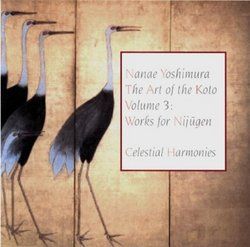Return of the King of all Koto CDs
Crazy Fox | Chicago, IL USA | 05/30/2006
(5 out of 5 stars)
"Good things come in 3's, I guess. Like its two predecessors, this is really an excellent CD of koto music, making for an incredible trilogy. Once again, the sound quality is crystal clear, the performances inspired and superb, and the music itself very beautiful--in a rather different way this time. Strange even, but it works all the same.
The prior two "Art of the Koto" CDs covered the historical development of koto music from the 1600's until the early 1900's, and so this album picks up where they left off by covering the innovations of the late twentieth century (from 1969 to 1989). Appropriately enough, all the music here is played on the 21-string koto invented after WWII rather than on the usual 13-string koto. The first track, composed by Miki Minoru (the guy who formed Pro Musica Nipponia, the music group that brought us the great album "Japan: Traditional Vocal and Instrumental Music") is weird and experimental...almost harsh on the ears sometimes. The second piece (five tracks), by Nagasawa Katsutoshi, is hauntingly beautiful and meditative. The third composition (two tracks) is by Miki Minoru again, this time more like the kind of music I'm used to by him, skillfully blending traditional Japanese music with modern musical sensibilities in a new and wonderful synthesis. "Nanae" by Nishimura Akira is somewhat similar to track one: eerie and experimental, abrupt and harsh on the ears in spots but still strangely appealing in a twilight zone way. Finally, Sato Somei's composition is rather alien sounding in a quiet, retro-primitive manner--a creative imagining of what protohistorical Japanese koto music for the deities might have sounded like (talk about full circle). These are all pretty unique selections, too--I doubt you'll ever find them on another CD in the States.
Again as with volumes one and two, the liner notes for this album are incredibly extensive and full of detail. It's wonderfully clear that much effort went into them, and one gets a real crash course in modern koto music from reading along--this is especially important in volume three's case, as this CD covers ground not usually found elsewhere. First we get a good description of the 21-string koto, its invention and history, and its place in the overall development of koto music as a whole. Next each track is introduced and explained in fine, loving detail--including lots of information about each individual composer. And musicological details for the music expert are included as is usual with this series. Finally, each performer is introduced along with a quick summary of her or his career.
Like volumes one and two, this is an excellent CD on all counts. As an album it may very well stand on its own well enough, but listening to it after the prior two volumes is probably better. My sense is that it may be hard to appreciate what the composers and musicians are accomplishing if unaware of the musical tradition they are building upon and innovating in new directions. Also this is very atypical koto music (even the actual instrument is atypical) so I wouldn't recommend this CD as an introduction nor as a first koto CD. If you've listened to volumes one and two or otherwise familiarized yourself with the Japanese koto, though, this stuff will blow you away."


 Track Listings (10) - Disc #1
Track Listings (10) - Disc #1